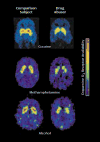Drug addiction and its underlying neurobiological basis: neuroimaging evidence for the involvement of the frontal cortex
- PMID: 12359667
- PMCID: PMC1201373
- DOI: 10.1176/appi.ajp.159.10.1642
Drug addiction and its underlying neurobiological basis: neuroimaging evidence for the involvement of the frontal cortex
Abstract
Objective: Studies of the neurobiological processes underlying drug addiction primarily have focused on limbic subcortical structures. Here the authors evaluated the role of frontal cortical structures in drug addiction.
Method: An integrated model of drug addiction that encompasses intoxication, bingeing, withdrawal, and craving is proposed. This model and findings from neuroimaging studies on the behavioral, cognitive, and emotional processes that are at the core of drug addiction were used to analyze the involvement of frontal structures in drug addiction.
Results: The orbitofrontal cortex and the anterior cingulate gyrus, which are regions neuroanatomically connected with limbic structures, are the frontal cortical areas most frequently implicated in drug addiction. They are activated in addicted subjects during intoxication, craving, and bingeing, and they are deactivated during withdrawal. These regions are also involved in higher-order cognitive and motivational functions, such as the ability to track, update, and modulate the salience of a reinforcer as a function of context and expectation and the ability to control and inhibit prepotent responses.
Conclusions: These results imply that addiction connotes cortically regulated cognitive and emotional processes, which result in the overvaluing of drug reinforcers, the undervaluing of alternative reinforcers, and deficits in inhibitory control for drug responses. These changes in addiction, which the authors call I-RISA (impaired response inhibition and salience attribution), expand the traditional concepts of drug dependence that emphasize limbic-regulated responses to pleasure and reward.
Figures







References
-
- Blum K, Braverman ER, Holder JM, Lubar JF, Monastra VJ, Miller D, Lubar JO, Chen TJ, Comings DE. Reward deficiency syndrome: a biogenetic model for the diagnosis and treatment of impulsive, addictive, and compulsive behaviors. J Psychoactive Drugs. 2000;32(suppl i–iv):1–112. - PubMed
-
- Koob GF, Caine B, Markou A, Pulvirenti L, Weiss F. Role for the mesocortical dopamine system in the motivating effects of cocaine. NIDA Res Monogr. 1994;145:1–18. - PubMed
-
- Di Chiara G. Drug addiction as dopamine-dependent associative learning disorder. Eur J Pharmacol. 1999;375:13–30. - PubMed
-
- Volkow ND, Wang G-J, Fowler JS, Logan J, Gatley SJ, Hitzemann R, Chen AD, Dewey SL, Pappas N. Decreased striatal dopaminergic responsiveness in detoxified cocaine-dependent subjects. Nature. 1997;386:830–833. - PubMed
-
- Liu X, Matochik JA, Cadet JL, London ED. Smaller volume of pre-frontal lobe in polysubstance abusers: a magnetic resonance imaging study. Neuropsychopharmacology. 1998;18:243–252. - PubMed
Publication types
MeSH terms
Substances
Grants and funding
LinkOut - more resources
Full Text Sources
Other Literature Sources
Medical
Miscellaneous

